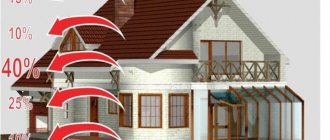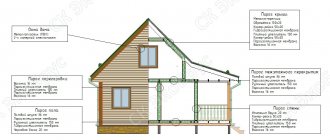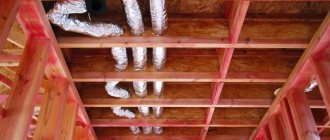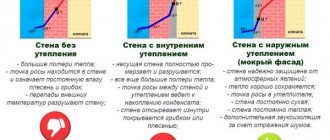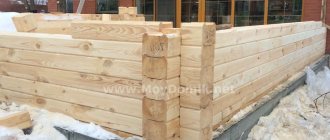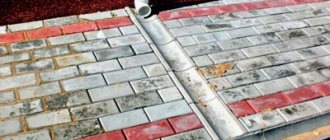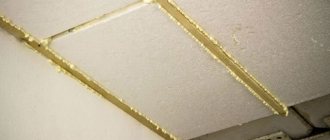During the construction or renovation of housing, the owners are faced with a dilemma: save on thermal insulation and subsequently spend significant funds on heating, or still insulate and live in comfortable conditions with minimal expenditure on heating from the family budget.
Insulation needs to start from the ceiling. There are several reasons:
- heat loss through 1 m2 of ceiling is several times higher than that of walls, firstly, due to the fact that the ceiling is much thinner, and secondly, warm air rises, as a result of which heat transfer by ceiling structures from inside to outside is carried out much more more intense;
- On an uninsulated ceiling with a cold roof (sometimes called ventilated), condensation occurs intensively. And this is dampness, mold and mildew.
You can insulate the ceiling with a variety of thermal insulation materials, from purchased ones to improvised ones, such as moss, foliage, straw, reeds, etc. Continuing the series of articles on the StroyGuru portal about insulating different building structures with various insulation materials, in this work we will talk about how to properly insulate a ceiling with mineral wool.
Choosing mineral wool for ceiling insulation
When determining which mineral wool to choose for ceiling insulation, you need to focus on:
- coefficient of thermal conductivity;
- density;
- thickness;
- lifetime;
- degree of noise absorption;
- price;
- manufacturer (brand).
Thermal insulation properties
In terms of thermal insulation properties, slag wool is significantly inferior to its competitors. However, when insulating the ceiling from the outside, the thickness of the insulation layer does not play a significant role. When choosing insulation, this must be taken into account.
Density
Representatives of mineral wool have different densities. However, the weight loads on the ceiling beams are not critical. Therefore, you can ignore the weight indicators. The maximum permissible density is 80 kg/m3 with an insulation layer thickness of 15 cm. Here slag wool loses to its competitors, because it requires a density of 125 kg/m3.
Thickness
The thickness of mineral wool for the ceiling is best calculated using an online calculator (located here). After all, minor errors lead to large heat losses. It’s one thing to be wrong by a couple of centimeters when insulating walls, where the masonry largely does not allow heat to pass through, and another thing when insulating the ceiling, where there’s insulation and finishing and nothing more.
The editors of the StroyGuru.Com website give the insulation thickness for central Russia based on accumulated experience:
For floors made of reinforced concrete slabs, the thickness of the thermal insulation layer is:
- for basalt wool at least 15 cm, while the insulation should be in 2 layers (one 10 cm, the second - 5 cm);
- glass wool - 15 cm plus 5 cm for caking. Total 20 cm;
- slag - 20 cm.
On wooden beams with a board or plasterboard underneath and a subfloor for the attic on top:
- basalt wool - 20 cm;
- glass wool - 20 cm plus 5 cm for caking;
- slag wool - 25 cm;
The same values apply to a suspended ceiling with a wooden base.
On wooden beams without filing underneath (puttying the surface of the insulation followed by painting) and a subfloor on top:
- basalt wool 25 cm;
- glass wool 25 cm plus 5 cm for caking;
- slag wool - 35 cm.
Conclusion: when insulating the ceiling from below, glass wool and slag wool greatly reduce the height of the room. Therefore, priority goes to basalt wool. Insulation between the beams eliminates slag wool. Any type of insulation can be used outside.
Durability
Glass wool should be chosen only if the thermal insulation will be replaced in 15-20 years. Otherwise, it’s just a loss of the family budget later.
Soundproofing
The real effect of reducing the noise load on residential premises is achieved when the density of mineral wool is 40 kg/m3 or more. Such indicators are only found in basalt wool and slag wool.
Price
If you have a small budget for insulation, it is best to buy slag wool and insulate it from the outside. However, it is quite difficult to find it on sale, despite the fact that it is included in the line of insulation from world brands (KNAUF). Therefore, the choice must be made between basalt slab and glass wool. The article “Which is better - basalt slab or mineral wool” will help in this matter.
Manufacturer
In the Russian construction market, the sales leaders are: “IZOVOL”, “TechnoNikol”, “Isover”, “KNAUF”, “URSA” and “Beltep” (Belarus), with the best combination of price and quality.
What should be the thickness of the insulation for the ceiling?
Some of the people who have insulated their ceilings with mineral wool complain about its quality: the appearance of excess moisture, drafts, and heat leaving the house. In fact, the reason is not the quality of the insulation, but a violation of the technological process during installation or its insufficient thickness. If the roof of the house is not insulated, and the ceiling belongs to the top floor of the building, then internal insulation alone will not be enough to maintain a normal microclimate in the room. The thickness of mineral wool depends on the specific structure. Here you need to take into account more than one factor in order to properly insulate the ceiling. The standard thickness of mineral wool for a house with an unheated attic is 10-16 cm. If the roof is not insulated, the insulation layer is doubled. But you can insulate the ceiling from two sides at once: internal and external. If a decision is made to insulate a pitched roof, the thickness of the insulation should be 15-30 cm. An important thermal insulation indicator is the quality of installation, and not just the installation itself.
Required materials and tools
Insulating the ceiling in a wooden house with mineral wool, just like in an apartment, will require the purchase of basic and auxiliary materials, as well as a set of tools. Need to buy:
- mineral wool;
- vapor barrier (windproof) membrane (type A or AM);
- vapor barrier film (type B or C);
- tape for gluing vapor barrier seams;
- polymer twine - necessary for additional fixation of fiberglass when performing insulation from below;
- strips for temporary fixation of sagging insulation;
- wooden beam for sheathing or a set of metal profiles;
- slats for counter-lattice;
- special dowels for fastening basalt wool;
- glue (each type of cotton wool has its own type);
- polyurethane foam.
The list of tools includes:
- stepladder;
- perforator;
- construction knife for cutting glass wool;
- a jigsaw or a sharp wave-shaped knife for cutting basalt slabs;
Special knife for cutting basalt wool.
- wood screws;
- screwdriver;
- stapler
Lamps and mineral wool
Wooden beams can only be used dry, otherwise the wet beam will bend, which will lead to damage to the suspended ceiling. Also purchased are hangers, screws, dowels, insulation, a vapor barrier - a special polypropylene membrane. In this case, only special ones can be used for recessed lamps in a suspended ceiling - small and closed in design, which do not require cooling from above. Since they will be covered with a layer of insulation and will not be ventilated.
Overhead lamps or a chandelier in the middle of the room, which can be suspended from a pin mounted in the ceiling, can also be used.
The position of the lamps is planned in advance, the electrical wiring is prepared. It will be mounted in a special shell on top of the beams in a layer of insulation.
When working with glass wool overhead, it is extremely important to follow safety precautions. It is recommended to work only in respirators, goggles, gloves and a thick headdress and clothing that prevents glass wool from getting on the body
After completion of work, the room should be cleaned with a vacuum cleaner and damp.
Preparatory work
Ceiling insulation with mineral wool should be carried out on an already prepared base. For concrete floors with insulation from below, the following work must be done:
- remove the lighting, insulate the wires using terminals or electrical tape;
- remove finishing: whitewash, paint or liquid wallpaper;
- tap the joints between the floor slabs. Remove loose plaster;
- prime twice and then seal the seams with gypsum plaster;
- repair cracks and chips with repair mortar;
- remove dirt, soot and volatile fats;
- prime the ceiling twice. The first layer of primer, diluted by 30-40%, is applied generously, in 2 passes. The second time the surface is primed after a day - it takes time for the first layer to set;
- a sheathing made of wooden slats or a metal profile is installed.
You can see how to properly mount the frame in the article “Do-it-yourself suspended ceiling made of plasterboard.”
A metal profile sheathing is installed.
The scope of preparatory work when insulating a concrete floor is reduced to cleaning the surface from debris and dust, eliminating the sharp ends of nails and screws of the rafter system and applying a primer in 2 layers.
Preparing to insulate a wooden ceiling is easier. During new construction, beams are treated with a fire-retardant solution. When carrying out repair work:
Fire protection.
- overhead lighting is being dismantled;
- old finishing is removed;
- dirty and sooty stains are removed. Fatty areas are treated with acetone or gasoline;
- the wood is treated with antiseptics and fire retardants;
- the bottom of the ceiling is primed;
- if necessary, the lathing is filled or a frame made of metal profiles is mounted.
Attention: many experts consider vapor barrier work to be a preparatory operation. In this article they are classified as the main technology, which does not change the essence.
Insulation technology
You can insulate the ceiling using several technologies:
- on top of the concrete floor;
- from inside the premises;
- from above onto the rough ceiling;
- between beams;
- underneath there is a flooring made of boards.
Insulation of concrete floors from the outside
The easiest way to retain heat escaping through concrete ceilings is to insulate it from the attic side. The step-by-step instructions are as follows:
- the surface of the overlap is treated with a primer twice;
- the concrete is covered with roofing felt overlapping and extending onto the walls by about 15 cm. The joints are glued with bitumen mastic;
- the first layer of basalt mats is laid. The slabs are stacked tightly to each other. In this case, the transverse seam of the second row should not coincide with a similar seam of the first row. The mats do not need to be fixed to the ceiling at all, but can be fixed with glue or special dowels with a large plastic cap;
Attention: lathing is required under glass wool and slag wool.
- a second layer of basalt wool is laid. In this case, the mats over the entire area should cover the joints of the first layer;
- the insulation layer is covered with a windproof membrane, the smooth side facing the insulation, with an overlap of at least 10 cm and overlapping the walls;
- The joints are taped with a special frost-resistant tape. The membrane is attached to the walls with a stapler or tape;
- roofing material is laid on top of the membrane in two layers or straight slate is laid. As a last resort, you can lay down several wide boards on which you can walk around the attic.
Note that savings on lathing and counter-lattice, as well as the mandatory flooring over glass wool or slag wool insulation, compensate for the higher cost of basalt insulation.
Insulation from below over concrete floors
Insulation of the ceiling with stone wool from below the concrete floor can be done using the “wet” method and over the lathing. Glass wool - only on the sheathing. Slag wool is not used.
Insulation using the “wet” method
To insulate a ceiling without lathing, use the following procedure:
- prepare glue from the dry mixture “CERESIT CT190” or “EK THERMEX - EK Chemical”;
- the adhesive mass is applied in a thin layer on the ceiling;
- mats 10 cm thick are pressed against the glue and smoothed over the entire surface so that the glue adheres to the basalt fibers. Hold for a couple of minutes, after which the next mat is pasted;
The rows of wool should be fastened with an offset.
- the second row should be offset relative to the first. To do this, cut the first slab of the second row in half or use the remainder from the first row. But it must be at least 15 cm wide;
- After the glue has dried, which is about 24 hours, the insulation is additionally attached to the ceiling with dowels. The mounting diagram is shown below;
Mat fastening scheme.
- The second layer is glued onto the first layer, but with mats 5 cm thick.
This is enough for a suspended or suspended ceiling. Before painting, the mats are reinforced on top with a reinforced serpyanka mesh and then puttied. You can see how to perform this operation in the work “Wall insulation with stone wool”.
Top of the rough ceiling
Insulation of the ceiling between the beams on the rough ceiling is carried out in the following sequence:
- Perpendicular to the beams, the ceiling is waterproofed under basalt wool (roofing material) and vapor barrier is carried out with polyethylene film under glass wool or slag wool. Sometimes roofing felt is laid under the film, which is unnecessary. Some experts recommend laying hydro- and vapor barrier along the beams, forgetting that wood perfectly absorbs and releases moisture. And this is detrimental to glass wool and slag wool. Roofing felt and film are laid overlapping, overlapping the walls. The seams of the roofing material are glued with bitumen mastic, and those of the film with tape;
Properly performed vapor barrier.
Roofing felt and film should go onto the walls.
Improperly performed waterproofing.
- mineral wool insulation is laid. The mats should lie flat, but at the same time fit snugly to the base, without bending (see picture);
Scheme of ceiling insulation with mineral wool.
- basalt wool is covered with a windproof film, other types of mineral wool are covered with a vapor barrier film;
- OSB boards or sheets are laid on top of the vapor barrier (for walking). If the ceiling space on the attic side is sewn up tightly, then there should be a ventilation gap of about 5 cm between the film (membrane) and the flooring.
Another option for insulating the outside of a rough ceiling: laying insulation on boards, plywood or OSB sheets laid on beams. A diagram of such insulation is shown in Fig. below.
Insulation diagram for a rough ceiling laid on beams.
This method is used only for basalt wool. The technology completely repeats all insulation operations on a concrete floor without a frame.
Peculiarities
To effectively use mineral wool as insulation, you need to take into account some of its features. Like all materials designed to provide effective insulation, mineral wool has both advantages and disadvantages.
There will be enough advantages, these include a whole list of parameters of such an insulating layer:
- Mineral wool does not burn, which improves the fire safety of the entire building.
- Rodents do not like this material too much, and if the conditions of its operation and installation are not violated, then they do not live in mineral wool.
- Mineral wool does not rot, which has a positive effect on its service life.
- Along with insulation, mineral wool also enhances the sound insulation of rooms.
- Temperature changes are not scary for her.
- The cost of such insulation will be one of the lowest.
Of course, you can’t do without negative aspects, and this insulation also has specific disadvantages.
- You cannot compress, tamp or otherwise deform sheets of material - this will cause the wool to lose its heat-insulating properties.
- Getting wet should also not be allowed, since in this case, the efficiency in maintaining heat is reduced to half of the calculated one.
- When working, be sure to use protective equipment for the respiratory tract and skin. If the dust generated when working with insulation gets on your hands or just on your skin, these places begin to itch desperately. Irritation may occur.
- This material should not be used in areas where the temperature can be high - near fireplaces and stove pipes. Basalt wool, which is insensitive to high temperatures, is better suited here.
Some are afraid to use this type of heat insulator because of the phenol it releases during operation. It is indeed present in some types of such products. But, with proper operation and temperatures not exceeding those permissible for mineral wool, it does not emit phenol.
